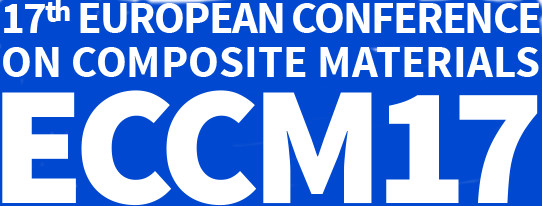

App-Einstellungen:
SIMULATION METHOD FOR THERMOFORMING OF APPLICATION-ORIENTED TEXTILE STRUCTURES AND MULTI-LAYERED REINFORCED ORGANOSHEET
Dominic Schommer (Institute for Composite Materials) Miro Duhovic (Institute for Composite Materials) Christian Goergen (Institute for Composite Materials) Joachim Hausmann (Institute for Composite Materials)
This paper shows new improvements on a hybrid simulation method for modeling the thermoforming process for organosheet materials which make it possible to use the method for all customized reinforcement structures.
THE COMPRESSION BEHAVIOUR OF NON-CRIMP FABRICS COMPOSITES FOR AUTOMOTIVE APPLICATIONS
Modesto Mateos (Mondragon Unibertsitatea) Maider Baskaran (Mondragon Unibertsitatea) A. Aizpuru (Mondragon Unibertsitatea) Laurentzi Aretxabaleta (Mondragon Unibertsitatea) Jon Aurrekoetxea (Mondragon Unibertsitatea)
The relaxation of a dry (no binder) 50k carbon fibre Non-Crimp Fabric (NCF) under maximum compression stage has been characterised for 3 different fibre volumes and fabric layer quantities by the use of fractional models.
VISUALIZATION EXPERIMENT AND NUMERICAL SIMULATION OF LIQUID IMPREGNATION WITH RACE-TRACKING FOR RTM PROCESS
Masatoshi Kobayashi (HONDA R&D) Koji Dan (HONDA R&D) Tsuyoshi Baba (HONDA R&D) Koshiro Yamakawa (Toray) Ryo Nakano (Computer Aided Engineering Business Div.)
In order to predict impregnation with race-tracking, we proposed 3D numerical simulation by the Darcy equation and variable fluid conductance equation that could reproduce the Stokes flow. This method could represent actual complicated impregnation.
MESOSCOPIC DRAPING SIMULATION OF OUT-OF-AUTOCLAVE PREPREGS AND EXPERIMENTAL VALIDATION
Mathias Engelfried (University of Stuttgart) Patrick Böhler (University of Stuttgart) Tomás Nosek (Mecas Esi) Frieder Heieck (University of Stuttgart) Peter Mittendorf (University of Stuttgart)
The presentation deals with different mesoscopic and macroscopic simulation approaches to predict the draping behaviour of NCF prepreg materials. The material models’ generation as well as their validation by experiments are presented.
DEVELOPMENT OF A NUMERICAL APPROACH TO PREDICT PROCESS INDUCED DEFORMATIONS DURING CURE OF FIBRE-REINFORCED STRUCTURES
A. Vandenbrande (Technical University of Dresden) Uwe Schuster (Technical University of Dresden) Andreas Hauffe (Technical University of Dresden) Klaus Wolf (Technical University of Dresden)
Shape distortions of prepreg structures occurring during autoclave cycles are a common problem. A new method has been developed, where the spring-in of complex structures can be predicted very accurate, fast and without excessive experimental effort.
HIGH-RATE, SPRING-IN COMPENSATED, NET-SHAPE MANUFACTURING OF RTM MADE COMPOSITE FRAMES WITHIN THE EU PROJECT MAAXIMUS
Erik Kappel (German Aerospace Center) Björn Reinhard (German Aerospace Center) Tim Roser (Airbus Helicopters)
The paper reports simulation-based prediction of process-induced distortions and the corresponding compensation of an RTM injection tool.
INFLUENCE OF THE FIBRE VOLUME FRACTION PARAMETER ON THE PREDICTIONS OF THE CURE-INDUCED DEFORMATIONS IN THERMOSET COMPOSITE PARTS
Antoine Parmentier (Cenaero) Benoit Wucher (Cenaero) David Dumas (Cenaero)
The present study focuses on quantifying the influence of the fibre volume fraction parameter on the prediction of the cure-induced deformations in order to evaluate the level of refinement to introduce in the numerical model.
MODELLING THERMAL DEFORMATIONS IN CURVED COMPOSITE LAMINATES USING STANDARD SHELL FINITE ELEMENTS
Enrique Graciani (Universidad de Sevilla) Antonio Bláquez (University of Seville) Jesús Justo Estebaranz (Universidad de Sevilla) Federico París (Universidad de Sevilla)
A new modelling procedure for predicting the spring-in of L-shaped composite samples using standard shell FE models (with suitably modified in-plane coefficients of thermal expansion) is presented and successfully compared with solid FE models.
NUMERICAL OPTIMIZATION AND SENSITIVITY ANALYSIS OF PULTRUSION PROCESS PARAMETERS
Alexander Safonov (Skolkovo Institute of Science and Technology (Skoltech)) Anton Saratov (Datacvance) Andrey Ushakov (Skolkovo Institute of Science and Technology (Skoltech))
The mathematical model of material behavior during pultrusion is implemented within ABAQUS environment. For numerical optimization and sensitivity analysis of process parameters, the simulation scheme was developed in pSeven software suite.
PRE-ASSESSMENT TOOL FOR DISTORTION IN FRAME-LIKE COMPOSITE STRUCTURES: INDUSTRIAL APPLICATION
Maximilian Lipcan (Airbus Helicopters) Johannes Mattheus Balvers (Airbus Helicopters)
It is strived for a pre-assessment tool for the early design phase that identifies earlier composite frame-like structures prone to distortion, by coupling their geometrical description to the spring-in equations of orthotropic strain mismatch.
